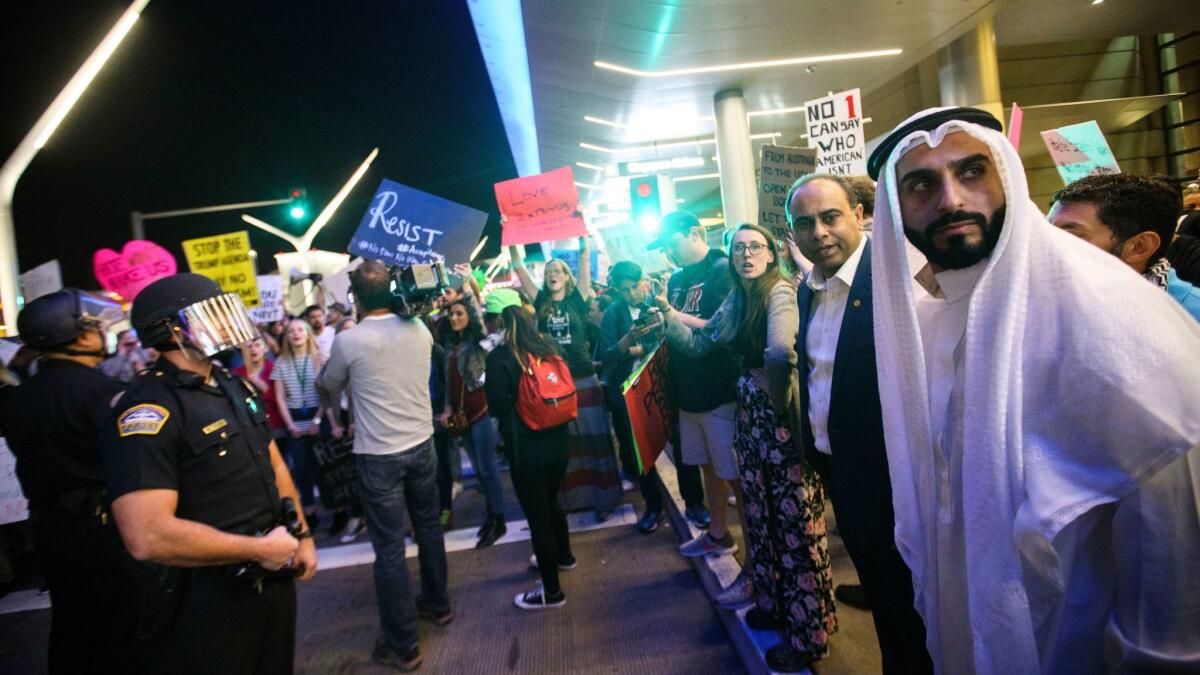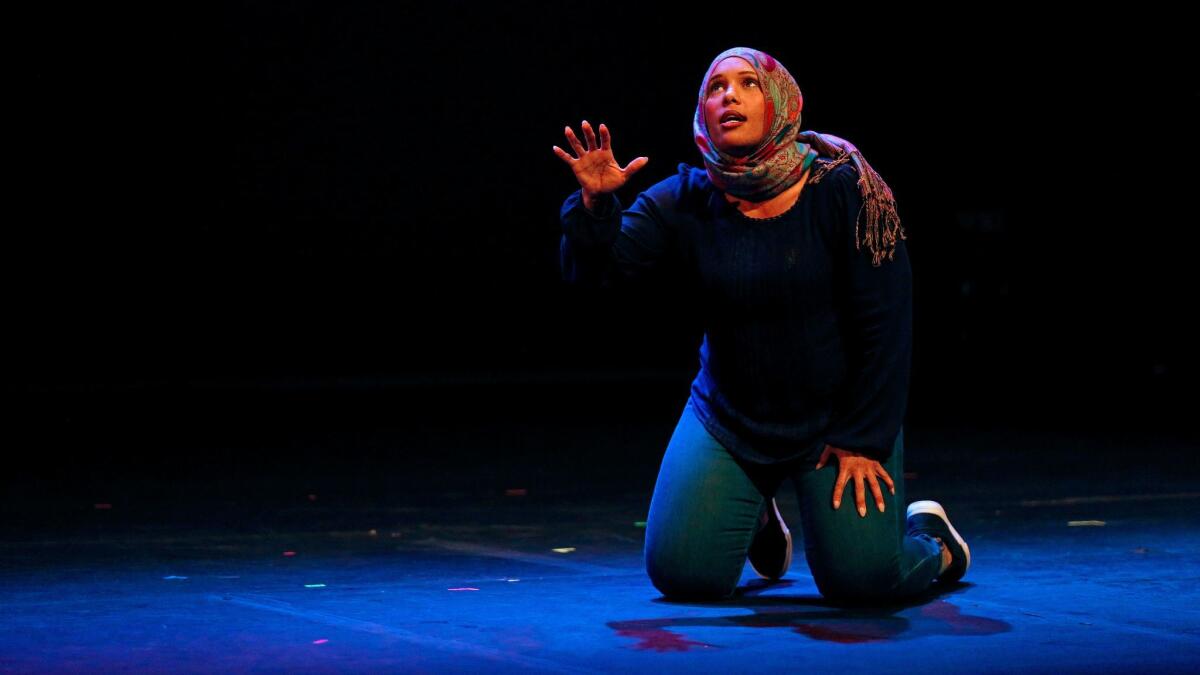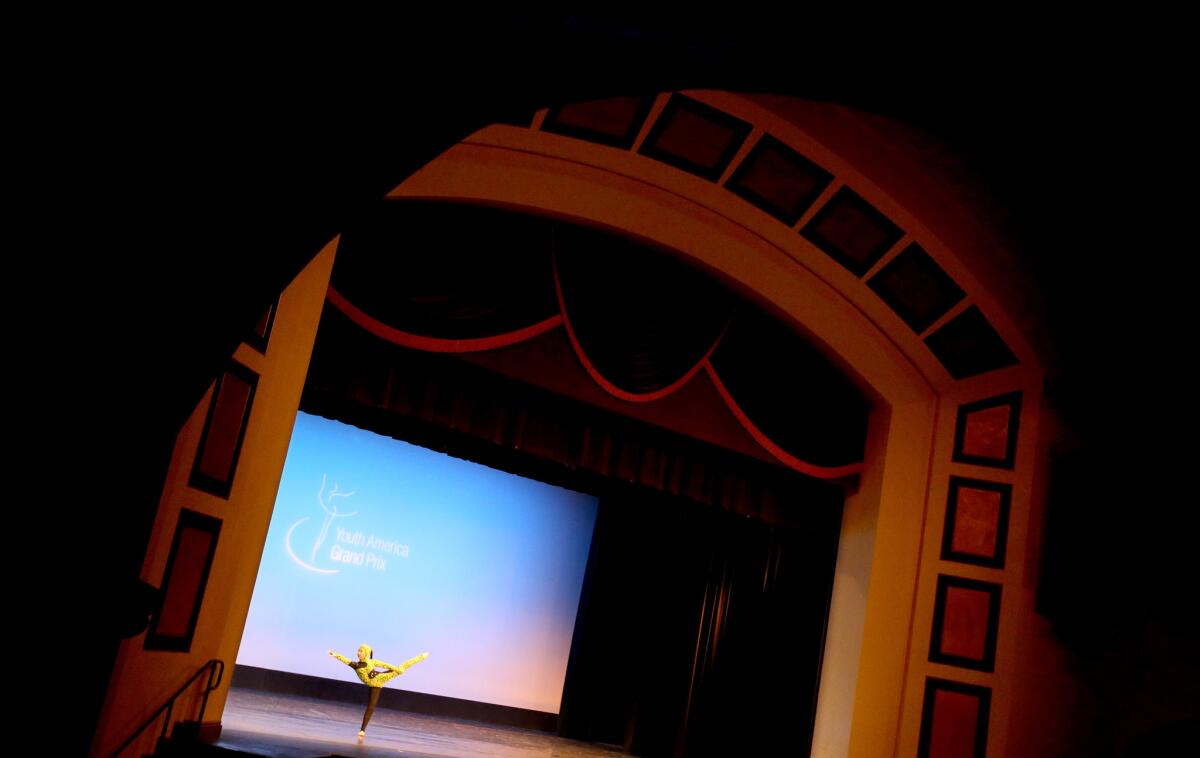Newsletter: Essential Arts & Culture: ‘Zoot Suit’ anew, art and the travel ban, Jimmie Durham’s timely sculptures
![A still from "La Poursuite du Bonheur [The Pursuit of Happiness]," 2003.](https://ca-times.brightspotcdn.com/dims4/default/9288b9e/2147483647/strip/true/crop/1800x1012+0+0/resize/1200x675!/quality/75/?url=https%3A%2F%2Fcalifornia-times-brightspot.s3.amazonaws.com%2F40%2F1a%2F38ae52a365b92f59042e2f68d54f%2Fla-cmiranda-1486085858-snap-photo)
- Share via
Art, theater, music and performance that resonate with this tumultuous moment in world history. I’m Carolina A. Miranda, staff writer at the Los Angeles Times, and your friendly neighborhood newsletter writer with the week’s most intriguing culture stories:
Art that throws stones
A new retrospective at the Hammer Museum of Arkansas-born artist Jimmie Durham (who claims Cherokee heritage) couldn’t be better timed, writes Times art critic Christopher Knight, “given deplorable declarations of American xenophobia now splashed across newspaper front pages.” Durham’s work — visceral assemblages that combine “cheekiness and humility” — hasn’t been shown in a significant way in the U.S. for two decades. But his art, Knight says, “speaks with a voice that is otherwise only heard in American life at times of profound crisis.” Los Angeles Times
Art, architecture and the travel ban

Airports around the country, including LAX, became sites of protest in the wake of Donald Trump’s travel ban. Times architecture critic Christopher Hawthorne looked at how the design infrastructure of these ports of entry served as curious stages for acts of civil disobedience. “Airports,” he writes, “are conveners for the kind of cosmopolitanism and multiculturalism that Trump’s nativist, ‘America first’ rhetoric has put squarely in the cross-hairs.” Los Angeles Times
I wrote about how artists and arts institutions are being affected by the travel ban. As artists poured into LAX to protest, organizations around Los Angeles are bracing themselves for a chill on cultural exchange. In an impassioned statement on the travel ban, James Cuno, president of the J. Paul Getty Trust, wrote: “The Getty stands against it and adds its voice in favor of established American principles of freedom and engagement.” Los Angeles Times

Times culture writer Jessica Gelt reported on a group of artists wielding their art as protest: the activist theater group Artists Rise Up Los Angeles, which was formed by producer and director Sue Hamilton in the wake of the 2016 election. In a performance that incorporated song, dance, spoken word and poetry earlier this week, the troupe took on some of the political issues of our age. “One can imagine these shows,” writes Gelt, “beginning to resemble the famously lewd, satirical and politically subversive cabarets of Weimar Berlin.” Los Angeles Times
Plus, Oscar-nominated Iranian film director Asghar Farhadi, of “The Salesman,” has announced he won’t attend the Academy Awards in protest of the ban, even if an exception were made for him. Times film and culture writer Jeffrey Fleishman, who has served as foreign correspondent in Iran, uses the news as a jumping-off point to explore his journeys through the region, and the issue of art in an era of divisive politics. Make this a must-read. Los Angeles Times
Meanwhile, The Times’ Deborah Vankin pays a visit to the exhibition “Focus Iran 2: Contemporary Photography and Video,” at the Craft and Folk Art Museum in Los Angeles — a juried biennial organized by the nonprofit Farhang Foundation. “We wanted to show different aspects of Iran than what’s typically covered in mainstream media,” director Alireza Rex Ardekani tells Vankin. “The more people know about a particular culture, and understand it, the less fear they will have about it.” Los Angeles Times
The return of ‘Zoot Suit’
“Zoot Suit,” the fabled musical by Luis Valdez, inspired by key moments in L.A. history — including the 1942 Sleepy Lagoon Murder and the Zoot Suit Riots of the ’40s — has returned to the stage at the Mark Taper Forum. In the role of the mythical character of El Pachuco: Oscar-nominated actor Demian Bichir. The Times’ Daryl H. Miller sat down with Bichir to discuss his approach to this otherworldly character. El Pachuco, says Bichir, is “a wise man, a wizard, a shaman. He’s good and he’s bad and he’s hideous and virtuous and he’s profane and reverential. He’s a trickster, a joker; he’s life and death.” Los Angeles Times
Plus: Times contributor Sylvie Drake speaks with Valdez, who talks about the childhood inspirations that drew him to theater, the roots of El Teatro Campesino, the roving theater troupe he established in the heady days of the farmworker movement, and the play that brought him international fame: “Zoot Suit.” His early work, writes Drake, represented a “combustion of raw energy, defiance, irony and joy.” Los Angeles Times
Gravity-defying Moby Dick and more
Herman Melville’s “Moby Dick” checks in at more than 500 pages — but Chicago’s Lookgglass Theatre Company has shrunken down this literary behemoth into a buoyant two hours of stage time that offer an impressionistic, yet stunning, view of Ahab’s obsessions. The production is now on view at South Coast Repertory through Feb. 19, and Times theater critic Charles McNulty describes it as a work of art that is well-suited to the moment. “A voyage into the heart of darkness,” he writes, “‘Moby Dick’ is still the most incisive guide to the lure of destruction that threatens to capsize all that our civilization has built up in its defense.” Los Angeles Times
McNulty also checked out Keith A. Wallace’s powerful solo performance piece “The Bitter Game” at the Skirball Center last week — a work that “brings the theatrical tool of emotional enlightenment to the issues that have given rise to the Black Lives Matter movement.” The story touches on well-covered subjects of gun violence and police brutality, writes McNulty, “but it’s how Wallace personalized the words and individualized the experiences that made the difference.” Los Angeles Times
And because too much theater is never, ever enough: The KOAN Unit ensemble has been staging a series of short plays by Samuel Beckett at the Odyssey Theatre in Los Angeles. In these five works — which include “Act Without Words II,” “Come and Go,” “Catastrophe,” “Footfalls” and “Krapp’s Last Tape” — McNulty says he found “resonances and divergences” and at least one piece that “resonated with our politically own turbulent moment.” But in staging so many plays at one go, he writes, there were signs of haste that would have driven “the famously stringent Beckett mad.” Los Angeles Times
A cry for a beloved country
Kurt Weill’s “Lost in the Stars,” inspired by the South African novelist Alan Paton’s anti-apartheid bestseller, “Cry, the Beloved Country,” was hailed for ushering in a new era in American opera when it first premiered on Broadway in 1950. Times classical music critic Mark Swed caught a rare revival staged by Anne Bogart and co-produced by UCLA’s Center for the Art of Performance. A work that examines the ways in which injustice thrives, “‘Lost in the Stars,’” writes Swed, “fit the mood of its time, and though rarely revived, it fits the mood of our own.” Los Angeles Times
A ballet competition fuels ambition

The Youth America Grand Prix, a national competition for young ballet dancers, landed in Huntington Beach last week, where children and teens staged their best choreographies for the possibility of landing scholarship money for a top dance school. The Times’ Gelt sat it in on the performances, where hundreds of young girls took to the stage as “little women” — “but offstage they are as small as their age would indicate.” Los Angeles Times
In other news…
— New York’s Museum of Modern Art is protesting the Trump administration’s travel ban by rehanging part of its permanent collection to feature works created by artists from Muslim nations — including pieces by the late Iraqi-born architect Zaha Hadid and L.A.-based painter Tala Madani, who was born in Iran. New York Times
— How the travel ban has affected the architecture community. Architectural Record
— New York City’s security estimate for protecting the Trumps in New York is more than double the budget for the National Endowment for the Arts. Hyperallergic
— Plus, the best visualization I’ve seen yet of the relative smallness of the NEA’s budget. New York Times
— A musical version of George Orwell’s “1984” is coming to Broadway. Huffington Post
— Marta Becket, the desert icon who made the Amargosa Opera House at Death Valley Junction a destination for performance, has died at the age of 92. Los Angeles Times
— Glafira Rosales, the woman at the center of an art fraud scheme that passed off works by an unknown artist as Modernist masters, and brought down the famed Knoedler & Company gallery, has been sentenced to time served. New York Times
— How Japanese American designers shaped American art and architecture in the post-World War II era — and how their World War II internment experiences shaped their lives and work. Essential reading from design writer Alexandra Lange. Curbed
— Enough with the obtuse dance titles, writes Lindsey Winship. The Guardian
— One word: Puppets. New York Times
— LACMA has acquired Random International’s popular “Rain Room” installation for its permanent collection. Los Angeles Times
— Plus, the Getty Research Institute has acquired artist Miranda July’s feminist DIY video archive, “Joanie 4 Jackie.” Curator Astria Suparak writes about what it was like to be part of that unusual video network. Los Angeles Times, The Iris
— The Times’ Makeda Easter looks at an exhibition at Inglewood’s Residency gallery, which offers a different way of picturing black men. Los Angeles Times
— And, an art critic has a go at Beyoncé’s pregnancy portrait. Plus, a little bit about Awol Erizku, the artist who made the pic. The Guardian, ARTnews
And last but not least…
Trump Tweets the classics. This is bigly funny. New Yorker
Sign up for our weekly Essential Arts & Culture newsletter »
ALSO
Artist Theaster Gates on W.E.B. DuBois and what Donald Trump doesn’t get about Chicago
More to Read
The biggest entertainment stories
Get our big stories about Hollywood, film, television, music, arts, culture and more right in your inbox as soon as they publish.
You may occasionally receive promotional content from the Los Angeles Times.










